There are about 22 salamanders in Maryland as listed by the Maryland’sWildlife & Heritage Service. Most of these salamanders are terrestrial at some point in their lives.
Only the mudpuppy and hellbender are aquatic throughout their entire life. The eastern newt is aquatic as an adult and also as a hatchling but they do have a terrestrial intermediate stage and in this stage, it is known as an eft.
The most common salamander within the state is the red-backed salamander which usually has a large red stripe on its back.
So what are salamanders? Well, they are amphibians that belong to the order Urodela. So although most salamanders are lizard-like, they are more closely related to frogs.
Table of Contents
Salamanders in Maryland
Family Ambystomatidae
These salamanders are referred to as mole salamanders and include a species known as mole salamander. This species isn’t endemic to Maryland.
1. Eastern Tiger Salamander
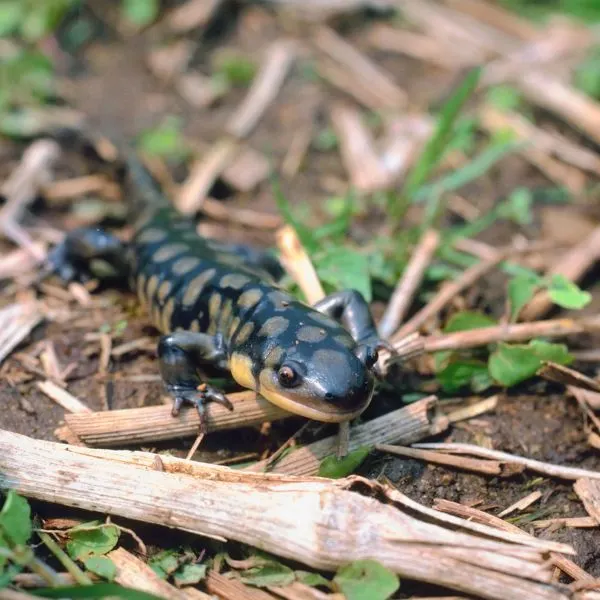
- Binomial Name: Ambystoma tigrinum
- Adult Length: 7 to 8¼ inches (17.8 to 21 cm)
- Record Length: 13 inches (33cm)
- Lifespan: 12 to 15 years
- Conservation Status: Endangered in Maryland
The tiger salamander is the largest terrestrial salamander in Maryland. This species has an average body length of about 7 to 8 inches and a record length of 13 inches. It is known as a tiger salamander because of the tiger stripes on its skin. These are irregular yellowish spots, bars, and blotches on the dark background.
The species inhabit deciduous and mixed forests close to “borrow pits” and vernal pools. The species do not breed in ponds with fish as these feed on the hatchlings.
2. Jefferson Salamander
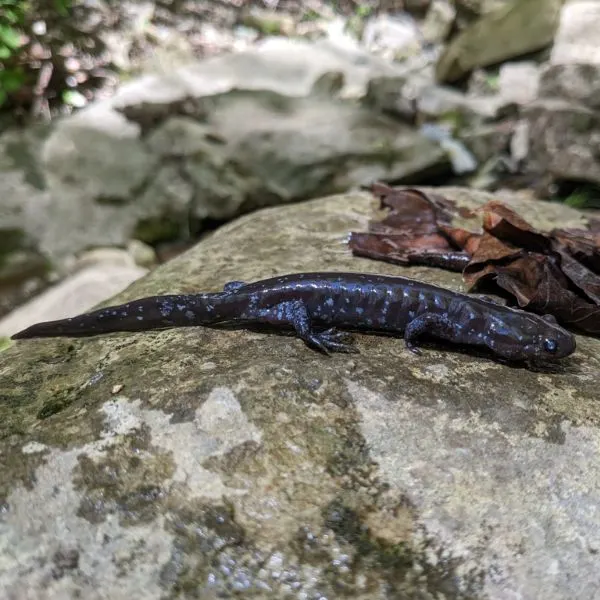
- Binomial Nomenclature: Ambystoma jeffersonianum
- Adult Length: 4¼ to 7 inches (10.8 to 17.8 cm)
- Record Length: 8¼ inches (21 cm)
Ambystoma jeffersonianum is quite large. It is slender in build. The snout and toes of this amphibian are long. The head is broad and flattened. The body is brownish black, brownish gray, or dark gray with whitish or bluish flecks on the body, head, tail, and limbs. Older adults generally have fewer flecks or no flecks. The underside is pale.
Ambystoma jeffersonianum has long tails which are almost as long as the body.
Similar to other mole salamanders, Ambystoma jeffersonianum is endemic to deciduous and mixed forests. The species is always close to water bodies such as river terrace pools, permanent small ponds, and vernal pools. The ponds that Ambystoma jeffersonianum breed in are generally absent of fish.
3. Marbled Salamander
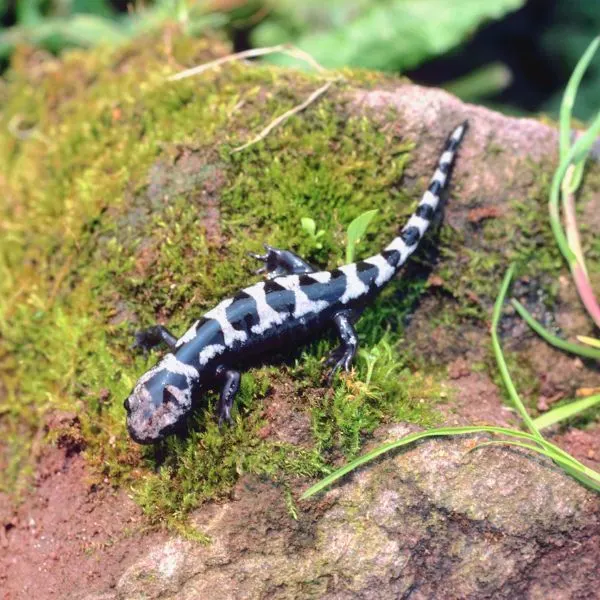
- Binomial Nomenclature: Ambystoma opacum
- Adult Length: 3.5 to 4.2 inches (8.89 to 10.67 cm)
- Record Length: 5 inches (10.2 cm)
- Lifespan: 3.5 to 4 years
The marbled salamander is a moderately sized and chunky salamander. There are several light crossbands on the back and sides on a black background. These crossbands are all of different shapes and widths. The crossbands are silvery white among males and silvery grey in females. The underside of the amphibian is also black.
The species inhabit deciduous and mixed forests near vernal pools.
Gravid females lay eggs during the fall when pools are dry. They then protect the eggs until the breeding pool floods.
4. Spotted Salamander

- Binomial Nomenclature: Ambystoma maculatum
- Average Adult Length: 6 to 7¾ inches (15 to 19.7 cm)
- Record Length: 9¾ inches (24.8 cm)
- Lifespan: 20 to 30 years
Ambystoma maculatum is quite large and can reach a length of almost 10 inches. Ambystoma maculatum is known as the spotted salamander because of the two rows of yellowish-to-orangish spots on the dorsum. There are individual spotted salamanders that lack these spots.
The spotted salamander is stout, unlike most other terrestrial salamanders.
Similar to other salamanders, this species inhabits wooded areas mainly deciduous bottomland forests and adjacent to rivers. They also inhibit mixed and coniferous forests as far as the habitat is humid and have vernal ponds.
The species is endemic to most of Maryland apart from the southeastern region (the lower Eastern Shore) as shown in the distribution map.
Family Cryptobranchidae
The species under this family are referred to as hellbenders. In Maryland, there is a single hellbender species.
5. Hellbender
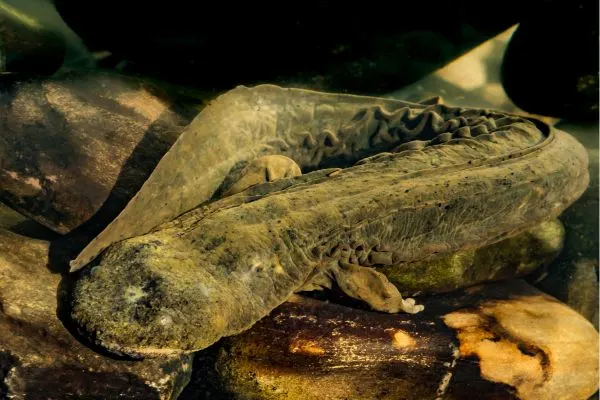
- Scientific Name: Cryptobranchus alleganiensis
- Adult Length: 11½ – 20 inches (30 to 50.8 cm)
- Record Length: 29⅛ inches (73.7 cm)
- Lifespan: 30 years
- Conservation Status: Endangered in Maryland
The hellbender is the largest salamander in Maryland. This amphibian is known to reach a length of 29.5 inches. The species is aquatic from hatchling to adult.
This large amphibian has a stout body with a fattened head and flattened body. The eyes are lidless and beady. A defining characteristic of the hellbender is the wrinkled folds of skin between the front and hind legs. The skin itself is slimy.
The species is dark with colors generally ranging from gray to brown. There are individuals that are green or yellow. The underside is lighter in color.
As a permanently aquatic amphibian, the hellbender has external gills.
The species is endemic to rivers and streams with a lot of rocks.
The species is endemic to Garret County. There are unconfirmed records of the species in Cecil County as well as Harford County.
Family Proteidae
Members of this family are referred to as waterdogs and mudpuppies.
6. Mudpuppy
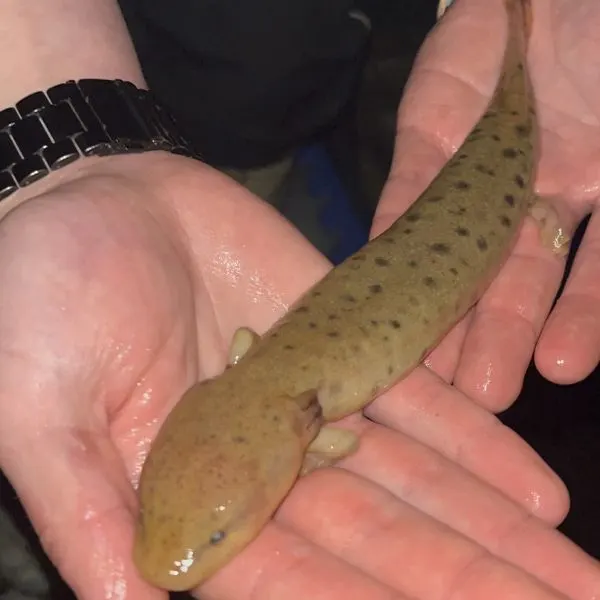
- Binomial Nomenclature: Necturus maculosus
- Adult Length: 8 to 13 inches (20 to 33 cm)
- Record Length: 19⅛ inches (48.3 cm)
- Conservation Status: Endangered-Extirpated in Maryland
The species is considered to be extirpated within the state. As such, it likely no longer exists within the state.
The mudpuppy is a large amphibian that can reach a length of 19 inches although most individuals are between 8 and 13 inches in length. This species is stout.
The mudpuppy is permanently aquatic and adults have large bushy gills which stick out. These gills are reddish.
Family Plethodontidae
Plethodontidae consists of lungless salamanders. These salamanders lack lungs and gills. They respire through their skin.
7. Green Salamander

- Binomial Nomenclature: Aneides aeneus
- Average Adult Length: 3¼ to 5 inches (8 to 12 cm)
- Record Length: 5½ inches (14 cm)
- Conservation Status: Endangered in Maryland, Global Rank – G3G4
The first lungless salamander we will be looking at is the green salamander. This salamander has bright green blotches on the back, head, and tail. These green blotches give the species its common name. This is the only salamander in Maryland with this coloration. This is a small salamander reaching adult lengths of 3 to 5 inches.
This salamander is a great climber and is generally found in rock crevices and trees close to rock outcrops.
The species is endemic to the westernmost county of the state – Garret County. The species is considered Endangered within the state.
8. Northern Dusky Salamander
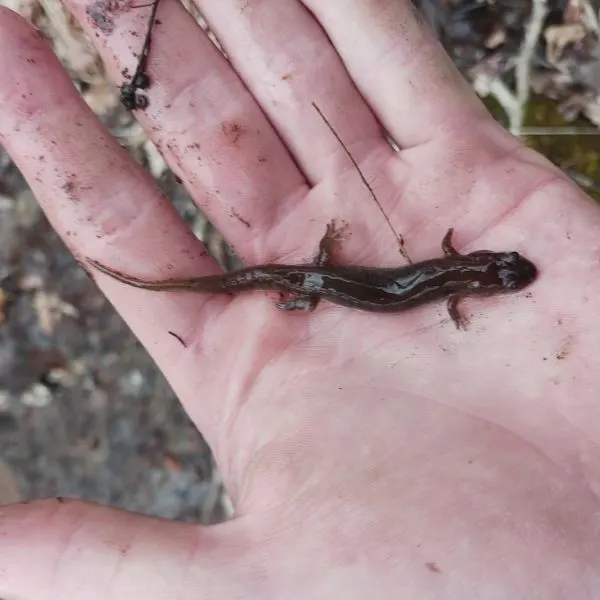
- Binomial Nomenclature: Desmognathus fuscus
- Adult Length: 2½ to 4½ inches (6.4 to 11.4 cm)
- Record Length: 5 inches (12.7)
This is a tiny salamander that reaches a length of 2 to 5 inches. The species exhibits highly variable patterns and coloration. However, most individuals are brown to grey. Desmognathus fuscus is stout with tiny limbs.
This amphibian is endemic to the edge of streams usually hidden under rocks or woody debris. They also live in seepage areas and springs of woodlands. They inhabit woodlands. The species is always close to water.
The species is found throughout Maryland.
9. Allegheny Mountain Dusky Salamander
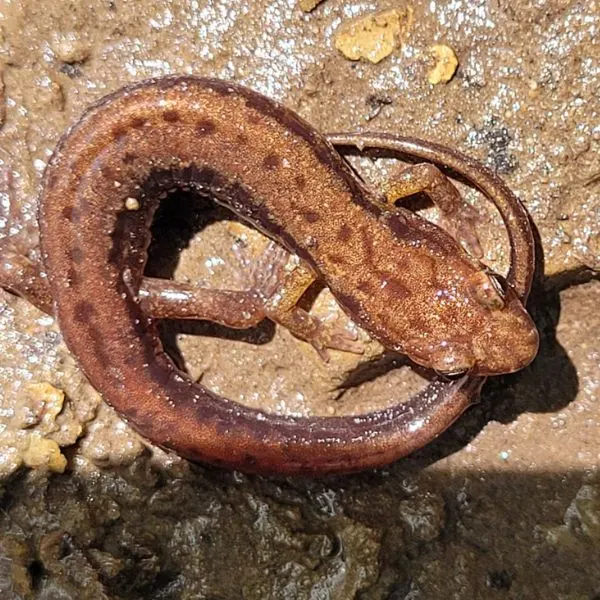
- Binomial Nomenclature: Desmognathus ochrophaeus
- Adult Length: 2.8 to 4 inches (7 to 10 cm)
- Record Length: 4⅜ inches (11.1 cm)
This is another tiny amphibian. The length of this dusky is 2.8 to 4 inches. The tail of this amphibian is roaded and has no keel. The coloration is brown with a large orange strip on its back. There are chevron-shaped dark spots within the stripe.
The species inhabits the Allegheny Plateau. Here, it hides under logs and rocks close to small streams. The rocks may even be in the streams. They can also be found in crevices in sandstone cliffs. They are never far from a water body.
The species is endemic to the Allegheny Plateau within Allegheny County and Garrett County.
10. Seal Salamander

- Binomial Nomenclature: Desmognathus monticola
- Adult Length: 3 ¼ to 5 inches (8.3 to 12.7 cm)
- Record Length: 5 ⅞ inches (14.8 cm)
Desmognathus monticola is a stout salamander which is light brown or gray with black or dark brown blotches. The tail is keeled and the tip is pointed. The underside is lighter in color. It may be uniform or have brown markings. Some individuals have a row of dots on both sides.
Desmognathus monticola inhabits rocky banks of mountainous streams. As a lungless salamander, it requires well-aerated water to respire. The species is always adjacent to a water body. The species also inhavit sprring-fed brroks and hardwood-shaded ravines.
Desmognathus monticola burrows and takes shelter in these burrows during the day. They are active during the night and perch on wet rocks in the stream/waterbody adjacent to the burrow.
Desmognathus monticola is endemic to Allegheny County and Garrett County.
11. Long-tailed Salamander
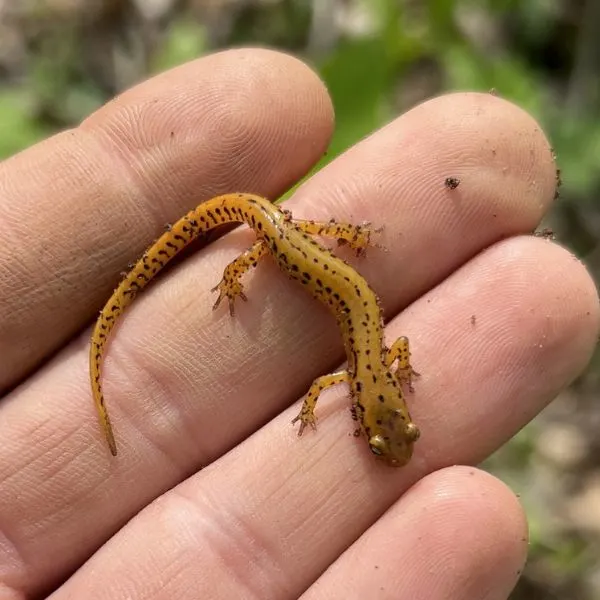
- Binomial Nomenclature: Eurycea longicauda
- Average Adult Length: 4 to 6¼ inches (10.2 to 15.9 cm)
- Record Length: 7¾ inches (19.7 cm)
The long-tailed salamander is a slender and moderately sized salamander. The tail is about 60% of the total body length. This long tail has broken twill weave-shaped patterns on each side. These markings are dark and contrast with the orange, yellow, or brown background. The entire body is orange, yellow or brown with black markings.
Eurycea longicauda inhabits cool areas with high humidity levels. These include ponds, caves, springs, seeps, and streams within forested areas.
Eurycea longicauda is endemic to the northern regions of Maryland.
12. Northern Two-Lined Salamander
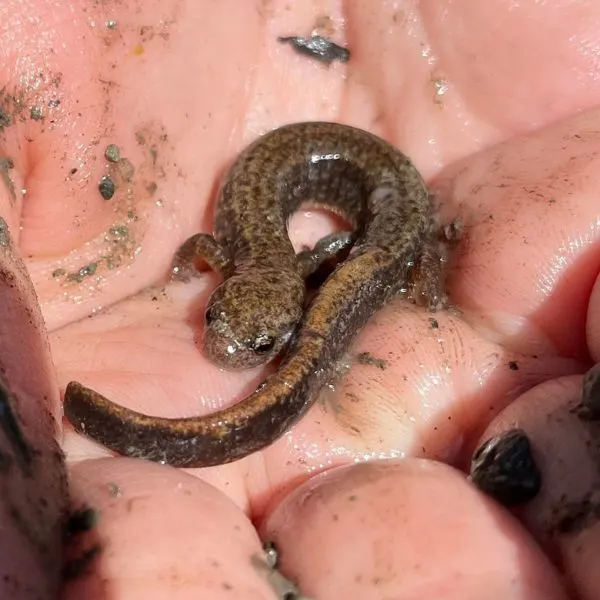
- Binomial Nomenclature: Eurycea bislineata
- Adult Length: 2½ to 3 ¾ inches (6.4 to 9.5 cm)
- Record Length: 4 ¾ inches (12.1 cm)
- Distribution in Mayland: Statewide
This is a tiny slender amphibian that is yellowish or orange to greenish with an orange or yellow back. There are two black stripes from the back of the eyes to the tip of the tail. The ventrum/underside of this amphibian is yellowish.
These two stripes give the species its common name. There are several black spots on the back of the two-lined salamander.
Eurycea bislineata is endemic to deciduous, coniferous, or mixed forests. Here they live close to seeps and streams. During the day, they hide under logs and flat rocks. They also inhabit forest floors during rainy weather.
13. Southern Two-lined Salamander
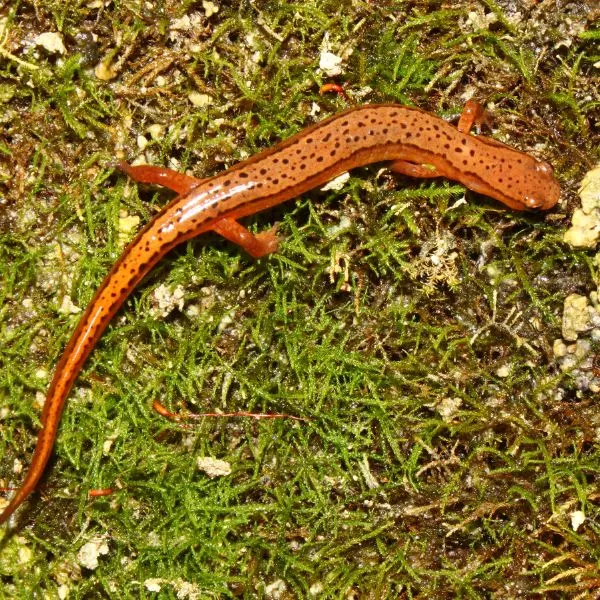
- Binomial Nomenclature: Eurycea cirrigera
- Adult Length: 2 ½ to 3 ¾ inches (6.4 to 9.5 m)
- Record Length: 4.3 inches (11 cm)
The southern two-lined salamander closely resembles the northern two-lined salamander. Both are tiny & slender, yellowish or orange to greenish in coloration with an orange or yellow back. There are two black stripes from the back of the eyes to the tip of the tail.
The main difference between the two species in terms of appearance is the number of costal grooves on each species. The northern two-lined salamander has 15 or 16 costal grooves while the southern two-lined salamander has 14 costal grooves.
There are several black spots on the back of Eurycea cirrigera. The ventrum/underside of this amphibian is yellowish.
Eurycea cirrigera is endemic to Worcester County. This is the only place it has been recorded. Here the species inhabit steams, floodplain wetlands, brooks, springs, and seeps. The species hide under leaf litter, wood debris, logs, and rocks.
14. Spring Salamander

- Binomial Nomenclature: Gyrinophilus porphyriticus
- Former Name: Northern Spring Salamander
- Adult Length: 4.5 to 7.5 inches (11.43 to 19.05 cm)
- Record Length: 8 ⅝ inches (21.8 cm)
For a lungless salamander Gyrinophilus porphyriticus is pretty large. This lizard-like amphibian is capable of reaching a body length of almost 9 inches. The species is stout and reddish. The coloration ranges from almond to reddish brown to orange or brownish pink. There are markings on the body which are darker than the background color but still quite muted.
It comes are no surprise that the spring salamander inhabits springs. They also inhabit west caves, wet depressions, mountain brooks, small headwater streams without predatory fish, and shaded seepages. They prefer cool humid locations.
The species is endemic to the western regions of the state. It is found throughout Garrett, Allegheny, and Washington counties. It is also found in the western portion of Frederick County.
15. Mud Salamander

- Binomial Nomenclature: Pseudotriton montanus
- Adult Length: 3 to 6½ inches (7.5 to 16 cm)
- Record Length: 8⅛ inches (21 cm)
- Former Name: Eastern Mud Salamander
This is a small to large salamander which can reach a length of 8 inches. The background color is red to reddish brown. There are several black spots on the back and side. It has brown beady eyes.
This species is known as the mud salamander because it is generally found in mud, to be specific the muddy environs of seeps and springs.
The species is endemic to the eastern regions of Maryland.
16. Red Salamander

- Binomial Nomenclature: Pseudotriton ruber
- Adult Length: 4¼ to 6 inches (10.6 cm to 15.2 cm)
- Record Length: 7⅛ inches (18.2 cm)
- Former Name: Northern Red Salamander
The red salamander is red in color with several black spots.
Its coloration gives it its common name. The red of Pseudotriton ruber ranges from salmon and orange to red. It is moderately sized with the largest reaching 7 inches in length. It closely resembles the mud salamander. Both are a similar hue of red. Both are also stout with keeled tails. However, the mud salamander has brown eyes while the red salamander has yellowish/golden eyes.
Similar to the other lungless salamanders, Pseudotriton ruber inhabit forested areas and are always found in and near flowing waterbodies such as streams. Here they burrow and bury themselves in the muddy sentiments of the stream. They also congregate in springs.
The species is endemic to most of the state.
17. Four-toed Salamander
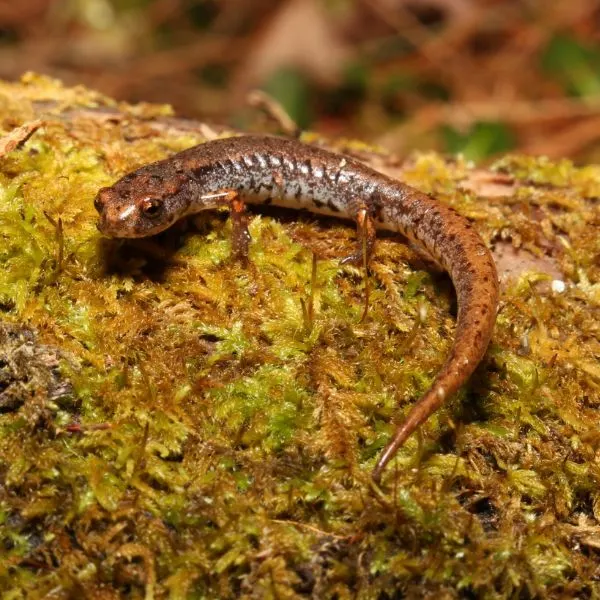
- Binomial Nomenclature: Hemidactylium scutatum
- Adult Length: 2 to 3½ inches (5.1 to 8.9 cm)
- Record Length: 4 inches (10.2 cm).
The four-toed salamander has four types pm its hind limbs. Most other salamanders have five toes on their hind limbs. It also has our toes on its front limbs. This is a small amphibian with a log tail which makes up about 50% of its total body length.
The coloration of the upper body is grayish to brownish with several small stops. The underside is white with tiny black spots.
The species is endemic to much of the state. Within the state, it is found within habitats with high humidity levels. These include fishless wetland habitats such as bogs, forested areas surrounding swamps, vernal pools, and slow-moving streams.
18. Eastern Red-backed Salamander
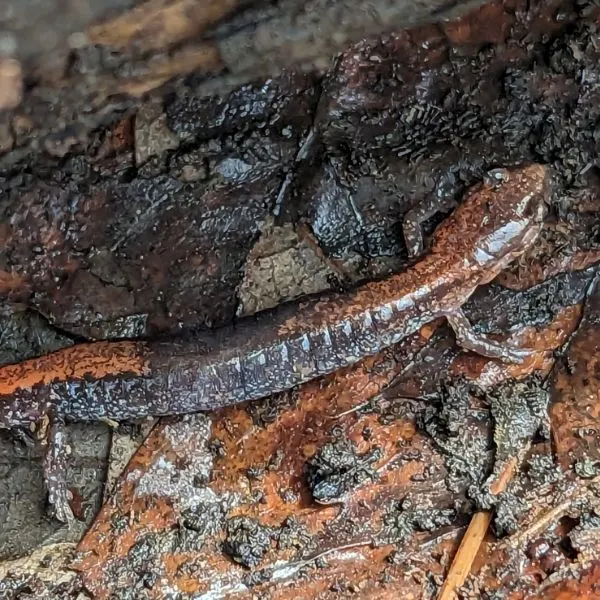
- Binomial nomenclature: Plethodon cinereus
- Adult Length: 2.5 to 4 inches (6.35 to 10.2 cm)
- Record Length: 5 inches (12.7 cm)
The redback salamander has a huge red stripe on its back. This stripe gives the amphibian its common name.
Not all individuals within the species have a red strip down the back. Some lack this stripe and are referred to as leadback.
The stripe is reddish, yellowish, or even orangish. The edges of the stripes are clean and straight and not wavy as in the case of the zigzag salamander.
The species inhabit forested regions of the state. During the day, they remain hidden under debris, logs, ad even rocks. They are considered the most common terrestrial salamander within the state. They are endemic to all the counties of the state.
19. Northern Slimy Salamander
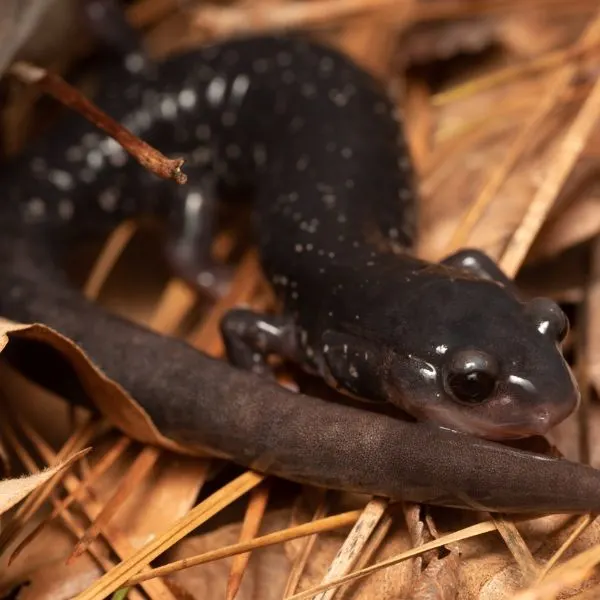
- Binomial Nomenclature: Plethodon glutinosus
- Adult Length: 4 ¾ to 6 ¾ inches (12.1 to 17 cm)
- Record Length: 8 ⅛ inches (20.7 cm)
- Average Lifespan: 5.5 years
- Range Lifespan: 20.1 years
This is a large salamander which is dark with tiny white spots all over the upper body. The color of the skin’s background is bluish-black or black and the white spots are brassy or silverly. The underside is lighter in color but is a similar color to the back. It has 16 costal grooves.
The species is known as the slimy salamander because it secretes sticky secretions when stressed. This secretion is difficult to wash off.
The species is endemic to forested /wooded areas including mature hardwood forests, shaded hillsides, wooded floodplains, and wooded ravines. The species inhabit all types of moist forested areas.
Plethodon glutinosus is endemic to the western portion of the state.
20. Valley and Ridge Salamander
- Binomial Nomenclature: Plethodon hoffmani
- Adult Length: 3 to 4 ½ inches ( 7.6 to 11.4 cm)
- Record Length: 5 ⅜ in (13.9 cm)
The valley and ridge salamander is a tiny slender salamander with a long unkeeled tail. The tail makes up over half its total body length.
Plethodon hoffmani itself is dark brown with several tiny white flecks on its upper body. The underside is equally dark in color with white mottling. The species closely resembles the leadback morph of the redback.
The species is endemic to western Maryland and occurs in Garret, Allegheny, and Washington counties. Within its geographic range, the species inhabit forested habitats such as mature hardwood forests. It is essential that its habitat has well-drained soils.
The species is also endemic to mountain slopes and ravines. Interestingly, the species is found in less humid regions. While other salamanders are found close to or in water bodies, the species can be found on the ground far from a water body.
21. Wehrle’s Salamander
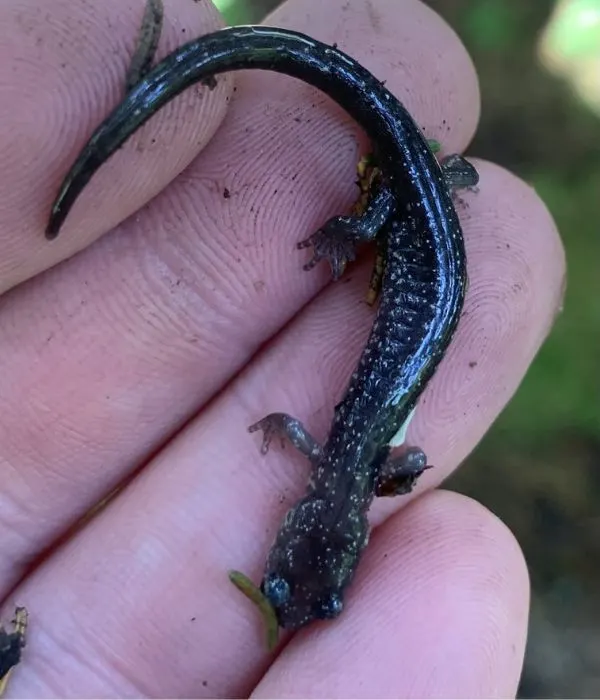
- Binomial Nomenclature: Plethodon wehrlei
- Adult Length: 3.9 to 6.7 inches (10 to 17 cm)
- Conservation Status: In Need of Conservation in Maryland
Plethodon wehrlei is endemic to the wesrnmost portion of Maryland and s found in Alleheny and Garrett counties. Here it lives in forested hillsides and mountainous aeas in mixed forests and deciduous forests. It is more accommodation of dry conditions and can be found in larhe number in these dry portions of its ecosystem.
They also live on flat rocks, rocky ledges, and in crevices. They also inhabit caves.
This is a a moderaley sized amphibian and can reach a length of almost 7 inches. It is dark brown with a wow of yellow or white spots and blotches. There are also iregular bands on its sides. The underside is gray with white spots.
Family Salamandridae
Salamandridae are commonly refered to as newts. The only newt in Maryland is the eastern newt.
22. Eastern Newt (Notophthalmus viridescens)
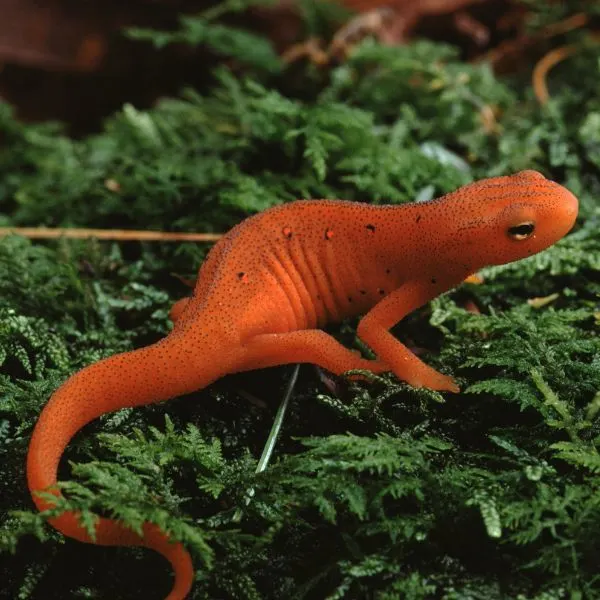
- Binomial Nomenclature: Notophthalmus viridescens
- Adult Length: 2.8 to 4.9 inches (7 to 12.4 cm)
- Former Name: Red-Spotted Newt
The eastern newt is a moderately sized amphibian. Adults are aquaitc but before that they are terrestrial efts. The eastern newt starts as aquatic hatchlings. They then develop into terrestrial efts before finally developing into aquatic adults.
The adults are yellowish to olive green in color with yellowsih undersides. As efts, they are red to orange in color with yellow spots that have black borders.
Hatchling live in vernal pools. Red efts live in most deciduoud forests. Aquatic adults live in streams, marshes, small lakes, piinds and vernal pools.
The species is found statewide.
Frequently Asked Questions
What is the commonest terrestrial salamander in Maryland?
The commonest or most common terrestial salamnder within the state is the eastern red-backed salamander (Plethodon cinereus). It is commonly known as the redback or leadback. The redback inhabit forested regions of the state. During the day, they remain hidden under debris, logs, ad even rocks. They are found in all the counties of the state.
What are the different types of salamanders in Maryland?
There are about 22 different types of salamanders in Maryland. These include some popular ones such as the tiger salamander, the marbled salamander, the spotted salamander and the red-backed salamander. Salamanders can be found in every county.
Are salamanders nocturnal or diurnal?
Salamanders are generally nocturnal. During the day, they hide under rocks, debris, and in burrows underground. They come out during the night when temperatures are low. They prefer cool humid conditions. During the rain, you may find salamanders out and about.
What are the newts in maryland?
There is just a single species of newt in maryland and this is the eastern newt.
Where can I find salamanders in Maryland?
Salamanders generally live in wooded and forested areas close to waterbodies such as streams, seepages, and springs. Some also inhabit the mouth of caevs. Yopu can also find some salamanders on rock faces and in rock crevices.
Do salamanders live in water or on land?
Most salamanders areterestrial as adults but a few are aquaitc and live inwater. Aquatic salamanders within the state include the mudpuppy, the eastern newt, and the hellbender. As hatchlings, salamanders are aquatic.
Conclusion
There are 22 salamanders endemic too maryland. These belong to five families namely – Ambystomatidae (mole salamanders), Cryptobranchidae (hellbenders), Proteidae (waterdogs & mudpuppies), Plethodontidae (lungless salamanders), and Salamandridae (newts).
Within the state, you can find salamanders in wooded and forested areas close to streams, seepages, & springs; near the mouth of caves; and on rock faces & crevices.
Salamanders is endemic statewide and live in every county. Since salamanders can be poisonous, it is best to avoid handing wild salamanders.
Five salamanders are endangered or threathened within the state. The endangered species are the eastern tiger salamander, green salamander, hellbender, and mudpuppy. The Wehrle’s salamander is considered ‘in need of conservation’.
Other nearby states

